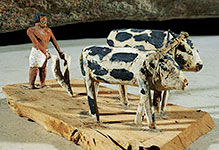
Egypt
Agriculture in ancient and modern Egypt

#03010116
Model of a grain storage house,with scribe noting entries. Four men carryi...

#03010118
Model of a farmer ploughing with two oxen, ca.2000-1900 BCE Wood...

#03010150
Counting the geese: mural from the tomb of Nebamun,from Thebes, 18th dynasty, a...

#03010158
Statue of Ramses II,19th dynasty,around 1250 BCE. The pharaoh is shown wearing...

#030102 5
Figure of a man with a hoe, from Assiut, Egypt, 6th Dynasty, c2250 BC. By the Ne...

#03010242
Servant wearing panther skin offering lotus to God Osiris (depicted with flail a...

#03010249
Coptic textile (linen and wool) showing a nilometer. Nereids and putti are depi...

#03030237
Relief of a harvest scene from the mastaba of Ipi. Saqqara, Egypt; Old Kingdom...

#03030266
An Egyptian terracotta figurine showing a man driving an Archimedean screw as a...

#080101 3
Trees, cacti, and plants in a religious painting of the vaulted tomb cham...

#080101 4
Peasant couple ploughing. Wallpainting in the vaulted tomb chamber of...

#080101 5
Peasant couple harvesting. Wallpainting in the vaulted tomb chamber of...